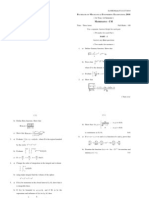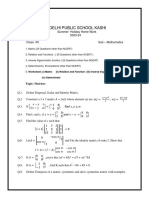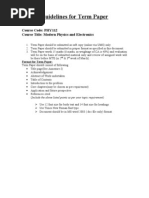0 ratings0% found this document useful (0 votes)
Linear Algebra Important Question
Linear Algebra Important Question
Uploaded by
atharvapawar71143Imp
Copyright:
© All Rights Reserved
Available Formats
Download as PDF, TXT or read online from Scribd
Download as pdf or txt
Linear Algebra Important Question
Linear Algebra Important Question
Uploaded by
atharvapawar711430 ratings0% found this document useful (0 votes)
Imp
Copyright
© © All Rights Reserved
Available Formats
PDF, TXT or read online from Scribd
Share this document
Did you find this document useful?
Is this content inappropriate?
Imp
Copyright:
© All Rights Reserved
Available Formats
Download as PDF, TXT or read online from Scribd
Download as pdf or txt
0 ratings0% found this document useful (0 votes)
Linear Algebra Important Question
Linear Algebra Important Question
Uploaded by
atharvapawar71143Imp
Copyright:
© All Rights Reserved
Available Formats
Download as PDF, TXT or read online from Scribd
Download as pdf or txt
You are on page 1/ 3
a) Define “Basis” of the vector space.
b) Consider 𝑅 𝑛 with Euclidean inner product space. Compute
<u, v>. where u = (1, 1, 1) , v = (-2, 1, 0) ɛ 𝑅 3 .
0 1
c) Find the Eigen values of𝐴 = [ ].
−1 0
3 0
d) Find the Eigen values of𝐴 = [ ].
8 −1
e) State Cauchy-Schwartz’s inequality.
f) Express 𝑝 = 1 + 2𝑥 − 𝑥 2 as a linear combination of
𝑝1 = 1 + 𝑥 , 𝑝2 = 1 − 𝑥, 𝑝3 = 𝑥 2 .
g) State whether W = {(x,y,z) 𝜖𝑅 3 / x+y=0, z= 0} is a subspace
of 𝑅 3 .
1
h) Let V = 𝑃3 (𝑥) with inner product <u, v> = 𝑎0 𝑏0 +
3
1 1
𝑎 𝑏 + 𝑎2 𝑏2 , for u =𝑎0 + 𝑎1 𝑥 + 𝑎2 𝑥 2 , v = 𝑏0 + 𝑏1 𝑥 +
4 1 1 7
𝑏2 𝑥 ɛ𝑃3 (𝑥). Find norm of 𝑃1 (𝑥 ) = 2 + 3𝑥 − 𝑥 2 .
2
i) Find the quadratic form q(x, y) corresponding to the
5 −3
symmetric matrix A= [ ].
−3 7
j) V=𝑅 3 , u = (𝑥1 , 𝑦1, 𝑧1 ) , v = (𝑥2 , 𝑦2, 𝑧2 ) ,
<u, v> =3𝑥1 𝑦1 + 2𝑥2 𝑦2 + 𝑥3 𝑦3 . Find norm of u = (1, 1, 1).
k) Determine whether the vectors are orthogonal in p with
standard inner product on 𝑝1 , 𝑝 = 2 − 𝑥, 𝑞 = 𝑥.
l) Define Affine Combination
m) Find the standard matrix corresponding to linear
transformation 𝑇: 𝑅 3 → 𝑅 2 defined as
T(x, y, z) =(x + y +z, -y +z).
n) Find the standard matrix corresponding to linear
transformation 𝑇: 𝑅 3 → 𝑅 5 defined as
T(x, y, z) = (2x + y -z, -y +2z, x-z, x +y -z, 2x).
o) Find the co-ordinate vector of a vector of u relative to the
basis B= {𝑣1 , 𝑣2 , 𝑣3 } for 𝑅 3 where u= (1, 2, 3),
𝑣1 = (1, 2, -3), 𝑣2 = (1, -3, 2), 𝑣3 = (2, 1, -5).
p) Determine whether the following is an inner product space
on R
<u, v> = 5𝑢1 𝑣1 − 𝑢1 𝑣2 − 𝑢2 𝑣1 + 10𝑢2 𝑣2 ,
where u = (𝑢1 , 𝑢2 ), v = (𝑣1 , 𝑣2 ).
q) Let 𝑇: 𝑅 2 → 𝑅 2 defined as T(x, y) = (x+ y, x). Determine
whether T is a linear transformation.
r) Let 𝑇: 𝑅 2 → 𝑅 2 defined as T (x, y) = (x+1, y+2). Determine
whether T is a linear transformation.
s) Find the eigen values and the eigen space corresponding to
2 1 1
the largest eigen value of the given matrix A= [2 3 2].
3 3 4
t) Find the eigen values and the eigen space corresponding to
2 1 1
the smallest eigen value of the given matrix A= [2 3 2].
3 3 4
3 1 1 4
u) Let𝑣1 = [1] , 𝑣2 = [2] , 𝑣3 = [7] & 𝑃 = [3]. Write P as an
1 2 1 0
affine combination of 𝑣1 , 𝑣2 , 𝑣3 if possible.
1 2 0
v) Let 𝑣1 = [3] , 𝑣2 = [ 7 ], 𝑣3 = [4] & 𝑆 = {𝑣1 , 𝑣2 , 𝑣3 }.
7 6.5 7
Determine whether S is affinely independence.
w) Find the basis & dimension of the column space of the
matrix
1 1 0 −1
𝐴 = [1 2 3 0]
2 3 3 −1
x) Find the basis & dimension of the column space of the
matrix
1 −2 0 3
2 −5 −2 6
𝐴=[ ]
0 5 10 0
2 6 8 6
3 −6 3 0
0 3 6 3
y) 𝑢1 = [ ] , 𝑢2 = [ ] , 𝑢3 = [ ] , 𝑝1 = [ ] & 𝑆 =
6 3 0 3
−3 0 3 0
{𝑣1 , 𝑣2 , 𝑣3 }. Determine whether 𝑝1 is spans S, aff S &
conv.S.
z) Given V=𝑅 2 is Euclidean inner product space with basis B=
{(1, 2), (2, 3)} using Gram-Schmidt’s process. Find
orthonormal basis of V.
aa) Use Gram-Schmidt’s process to transform the linear
independent set {𝑢1 , 𝑢2 , 𝑢3 } of 𝑅 3 into an orthonormal set
using Euclidean IPS where 𝑢1 = (1, 1, 1), 𝑢2 =
(−1, 1,0), 𝑢3 = (1,2, 1).
bb) Determine whether the matrix A is diagonalizable
2 0 0
𝐴 = [0 3 1]
0 0 3
You might also like
- Sheet 2 Vector Space - Subspace Linear Combination - Linear Dependency Span SetNo ratings yetSheet 2 Vector Space - Subspace Linear Combination - Linear Dependency Span Set4 pages
- Introduction To Engineering Mathematics I SemNo ratings yetIntroduction To Engineering Mathematics I Sem2 pages
- UNIT3 - 22MA2BSMCS - MES - QB Updated 21-07-2023No ratings yetUNIT3 - 22MA2BSMCS - MES - QB Updated 21-07-20236 pages
- List For Practicals of B.Sc. III (Maths)No ratings yetList For Practicals of B.Sc. III (Maths)3 pages
- Thane - FA1 - Grade 12 - Math - QP - 2024-25No ratings yetThane - FA1 - Grade 12 - Math - QP - 2024-254 pages
- PENANG 2013 STPM TRIAL PAPERS For Mathematics T TERM 2100% (3)PENANG 2013 STPM TRIAL PAPERS For Mathematics T TERM 28 pages
- Tutorial 3 (Mathematics-1) (Multivariable Caculus)No ratings yetTutorial 3 (Mathematics-1) (Multivariable Caculus)2 pages
- Sma1102 Tutorial Worsheet (All Sections)No ratings yetSma1102 Tutorial Worsheet (All Sections)2 pages
- Module III - Vector Space and Linear Transformations QBNo ratings yetModule III - Vector Space and Linear Transformations QB1 page
- Regular Arrear Examination - December 2013 Course: MAT202 - Linear Algebra Time: Three Hours Max - Marks:100 PART - A (10 X 3 30 Marks) Answer ALL QuestionsNo ratings yetRegular Arrear Examination - December 2013 Course: MAT202 - Linear Algebra Time: Three Hours Max - Marks:100 PART - A (10 X 3 30 Marks) Answer ALL Questions2 pages
- Linear Algebra-Assignment-3 Topics: Real Vector Spaces:, Linear Combination, Spanning Submission Date: 4 June 2019No ratings yetLinear Algebra-Assignment-3 Topics: Real Vector Spaces:, Linear Combination, Spanning Submission Date: 4 June 20192 pages
- 10 - HW Multivariable Functions ProblemsNo ratings yet10 - HW Multivariable Functions Problems3 pages
- Factoring and Algebra - A Selection of Classic Mathematical Articles Containing Examples and Exercises on the Subject of Algebra (Mathematics Series)From EverandFactoring and Algebra - A Selection of Classic Mathematical Articles Containing Examples and Exercises on the Subject of Algebra (Mathematics Series)No ratings yet
- Chapter 01. Basic Physics For Nuclear Medicine PDFNo ratings yetChapter 01. Basic Physics For Nuclear Medicine PDF101 pages
- The Magnetic Force: X X X X X X X X X X X X X X X X X XNo ratings yetThe Magnetic Force: X X X X X X X X X X X X X X X X X X35 pages
- Aperture Photometry Obtaining and Analysing A H-R Diagram of M38 v2.0No ratings yetAperture Photometry Obtaining and Analysing A H-R Diagram of M38 v2.014 pages
- Blue Print For Model Paper: Table 1 Weightage For Academic StandardsNo ratings yetBlue Print For Model Paper: Table 1 Weightage For Academic Standards5 pages
- Guidelines For Term Paper: Course Code: PHY112 Course Title: Modern Physics and ElectronicsNo ratings yetGuidelines For Term Paper: Course Code: PHY112 Course Title: Modern Physics and Electronics9 pages
- 3.1 - Newtons Laws Weight Qp-Gsce Edexcel Physics 1No ratings yet3.1 - Newtons Laws Weight Qp-Gsce Edexcel Physics 112 pages
- Magnetic Effect of Electric Current and Magnetism Short NotesNo ratings yetMagnetic Effect of Electric Current and Magnetism Short Notes4 pages
- University of Cambridge International Examinations General Certifi Cate of Education Advanced LevelNo ratings yetUniversity of Cambridge International Examinations General Certifi Cate of Education Advanced Level20 pages
- 《扫描透射电子显微镜成像理论 》(大牛Scott David Findlay 博士论文)No ratings yet《扫描透射电子显微镜成像理论 》(大牛Scott David Findlay 博士论文)244 pages
- CBSE Class Xi Physics Chap 14 - OSCILLATIONS - Revision NotesNo ratings yetCBSE Class Xi Physics Chap 14 - OSCILLATIONS - Revision Notes3 pages
- ATOMS: Development of The Atomic Theory DemocritusNo ratings yetATOMS: Development of The Atomic Theory Democritus3 pages
- Diwali Assignment SC 107: Kashyap Gohil November 2016No ratings yetDiwali Assignment SC 107: Kashyap Gohil November 20169 pages
- The Electromagnetic Spectrum by Cindy GriggNo ratings yetThe Electromagnetic Spectrum by Cindy Grigg2 pages

























































































